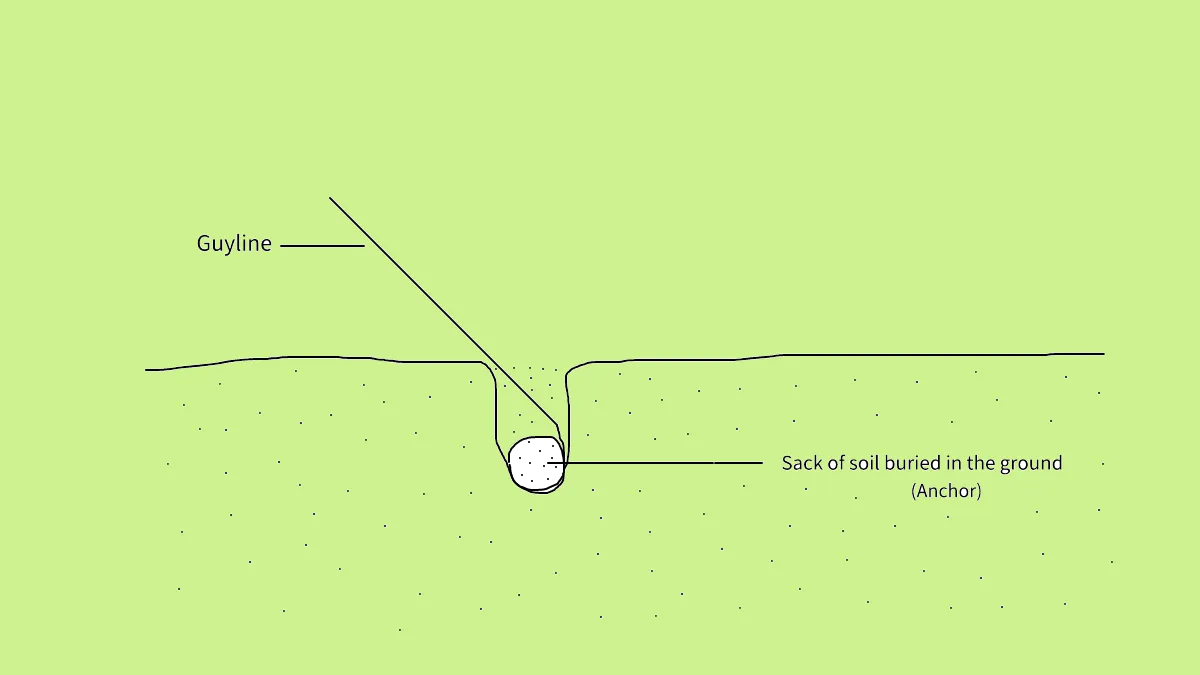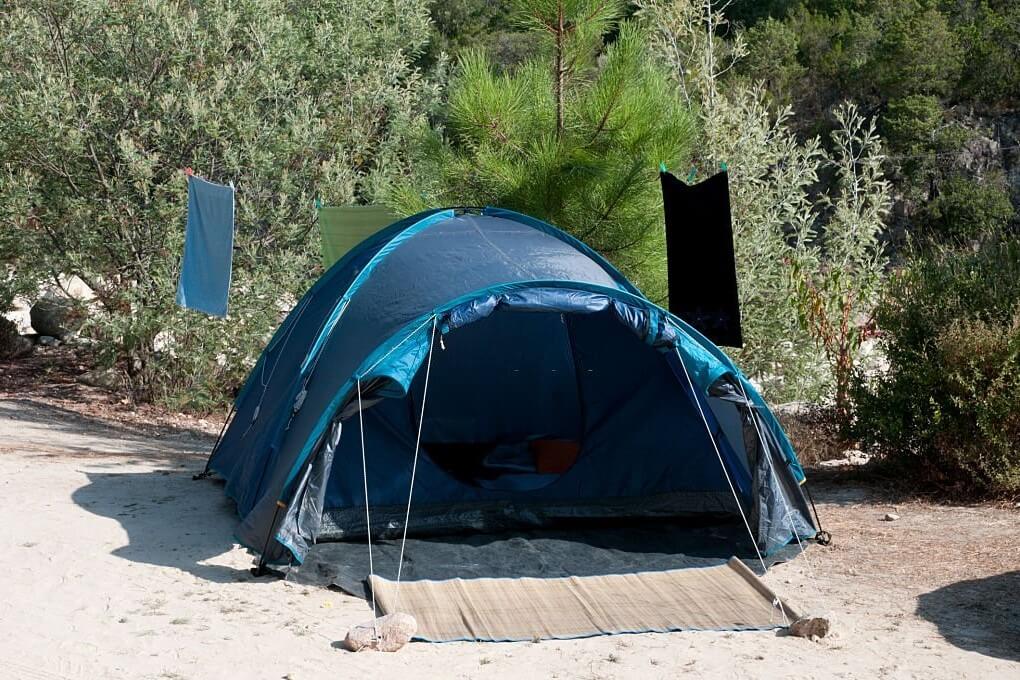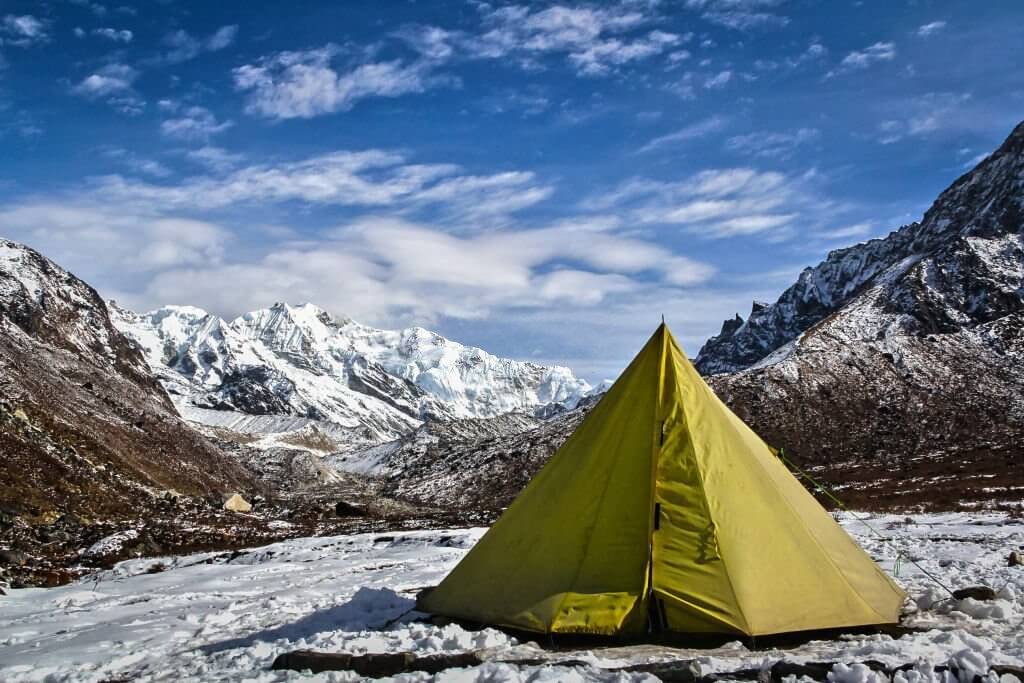- Camping Tips
- Hiking Tips
- RV Camping
- Destinations
- Blog
- Gear Reviews

Pitching a tent–the right way–is often a challenge for most campers. It can get even more desperate when your tent stakes are not compatible with the given terrain; or worse still if your stakes provide little to no anchorage.
Sandy, snowy, and rocky terrains are particularly some of the most difficult grounds to securely pitch a tent on. But with a deadman anchor, pitching on these types of terrains gets a little easier and quicker to accomplish.

Though the term “deadman anchor” might sound a bit ghoulish, it simply refers to burying an object in the ground for providing leverage or anchorage.
There is not much information about the origin of its name. But we guess that it is the idea of burying an object, as one would a coffin, then attaching a rope to it to anchor something that is above the ground.
Stories are also told of survivors who used their dead companions as buried snow anchors to rappel out of danger.
But nobody knows how the term came to be.
A deadman anchor, also known as a T-slot ground anchor, is a type of natural anchor that is popularly used in canyoneering, camping, and off-roading activities. It comprises a T-shaped or a horizontal trench, a load buried inside the trench, and a guyline to attach to what you need to be anchored.
Once set up, the buried load exerts some force onto the soil above it and in turn, the soil provides an equal amount of resistance. That said, there are a couple of factors that help determine how effective the anchor will be.
The type and density of the soil matter a lot when it comes to ground anchors. You want hardpack dirt, snow, sand, or gravel for the best anchorage. Else, you may have to dig a deeper hole to attain more capacity.
The direction of pull is equally important when it comes to the effectiveness of the ground anchor.
You want the guyline at a nice angle unobstructed by the walls of the trench. When digging your T-slot hole, always ensure that you bury the load deep enough and that the guy rope begins at the same depth. The vertical length of the T-slot should slowly incline with the slack of the rope towards the direction of pull.
This type of ground anchor is popular across the board be it in camping, construction, or even canyoneering, and for a good reason.
A deadman anchor is an inexpensive way of getting the much-needed leverage for your tailored use case. It is perfectly suited for unfriendly scenarios such as pitching a tent on snowy, rocky, treeless, or sandy terrains. In addition, deadman anchors can be improvised with aboveground loads such as rocks, trees, and weights.
However, digging a hole can be physically demanding and tedious especially during emergencies. Additionally, the deadman anchor is usable as a secondary support system meaning you will still need suitable tent stakes to use in tandem with the anchorage.
As we earlier alluded to, tent camping on certain grounds is made a whole lot more tolerable with the help of this type of ground anchor.
Rocky terrains will be hard to drive in your tent stakes. Sandy or snowy grounds will need more specialized stakes but that doesn’t guarantee that they will stick in the ground. Remember, without proper anchorage, you risk your camping tent being blown away in the process.
Other use cases for the deadman anchor include the following:
The deadman anchor is a useful and effective solution to help you conquer the outdoors. Read on for a primer on how best to make your own T-slot ground anchor.

Chances are that most of what you need to make the anchor is already present in your outdoor gear. For adventurous tent campers and hikers, you will need the following:
For backcountry car campers and overlanders, ensure your vehicle has a capable towing winch installed, and be sure to grab a suitable anchor load. Like in camping, the load will most likely be a strong parachute-stye fabric with leads to attach to your towing system.

Prepare your preferred campsite by compacting the area using your snowshoes, skis, or boots. The area should be a few inches larger than the diameter of your tent. Wait for at least half an hour for the area to freeze then proceed setting up your base anchors.
Firstly, tie your tent cord or guylines to the middle of your tent stakes using a suitable hitch, preferably one that is easy to undo for faster and easier disassembly. A round turn and two half-hitches knot or a girth hitch are both solid options to try.
Next, you want to dig the t-slot ground anchor with an entrenching tool on a suitable anchoring point. About six to twelve inches deep should do the trick for firmly packed snow, else you will want to dig deeper.
The slot should be bigger than the length of the tent stake or picket for better anchorage. Moreover, the longer side should be as deep as the horizontal at the beginning of its inclination.
Place down the tent stake horizontally into the freshly dug T-slot and slightly adjust the guy ropes to be taut. Then, cover the trench with snow and stomp it down to freeze it in place. Be sure to pack the snow down well to improve the resistance and prevent the tent stake and guyline from pulling out.
When burying the weight, always use the snow from the back to prevent compromising the “retaining” walls of your T-slot anchor. If the snow feels too powdery or slushy, then you will have to dig the anchor a little deeper. Otherwise, your anchorage will simply melt out.
Repeat the process for the other attachment points on your camping tent.

For sandy terrains, burying a sandbag tends to be more effective than using stakes as your anchor load. Creating the ground anchors begins by filling up a bag or a tent stuff sack with sand then tying off the top with a drawcord.
If your bag has no integrated drawcord, attach your guyline using a trucker’s hitch or any other suitable knot.
Dig the T-slot ground anchor with just about enough depth to fully bury the sandbag. Remember to place your guyline in the longer side of the T-slot then compact the anchor by stomping on it. If the grounds are too loosely packed, you can use some rocks instead of the sand for better anchorage.
Speaking of which, in rocky areas where digging would be impossible, we highly recommend pseudo deadman anchors. These include the T-bone and the Wrap rock anchors.
For the T-bone anchor, ensure the guyline is tied to a tent stake or block of wood at the middle and perpendicularly. Place the guyline on your preferred pitching area and stack a few heavy rocks in front of the tent stake.
On the other hand, the Wrap anchor entails wrapping the guyline around a big rock without any knots. Strong winds are unforgiving to poorly-pitched tents so you want to use large heavy rocks for the best results.
Do the same for all the anchor points in your camping tent and tension accordingly.
Like in canyoneering, you can experiment with water bags attached to the guylines if there is a water body close by. This would be applicable for loose sandy soil on beaches but might be a hit or miss.
If you partake in desert camping trips and adventures, you must be familiar with how frustrating it can be to get stuck in the sand. With a deadman anchor, you don’t have to waste your gas trying to wiggle yourself out of the conundrum.
The anchor works just as it would in tent camping. Simply dig a hole a few meters from the stuck truck and bury your parachute-style weight inside. Tie the leads from the weight system to your towing winch and gradually pull your vehicle towards the anchor.
While a rectangular-shaped hole is acceptable, you may want to stick with the more effective T-shaped version to avoid straining the anchor’s attachment ropes. If you don’t have a specialized anchor weight, a spare tire works just fine too.
If the vehicle doesn’t bulge, you can always dig a little deeper into the sandy terrain for better results. The same process can be used when you get stuck in the mud. Alternatively, you may use other complex systems such as the famed Pull-Pal winch anchor.
The Pull-Pall mechanism attaches to your towing winch and works by digging deeply into the ground as the winch cable tightens.
When it comes to the outdoor lifestyle, preparation is at the heart of everything. You want to have plenty of backup options if, for whatever reason, the deadman anchor doesn’t work out.
A freestanding camping tent is arguably easier to pitch on a wide variety of terrains. But it still falls short when camping in windy conditions. Therefore, investing in suitable tent stakes and being knowledgeable on other types of anchors is the way to go.
Sand and snow tent stakes are typically wider, shorter, and less pointy than other tent pegs. They may also feature numerous perforations running down their heights. Ideally, the holes fill up with sand or snow and in effect compact the anchor point.
The wider profile works wonders at preventing the pegs from getting pulled out of the ground when the guylines are under tension.
Other types of tent pegs for these tough terrains include the screw-style or pile driver options that can be twisted deep into the ground to offer support. The screw-style stakes often come with handles (some with detachable ones), which you can easily use to screw them into the ground. A good example of this is auger stakes.
Other tent stakes suitable for winter camping include snow flukes and snow pickets.
If you plan on camping on rocky grounds, get yourself some rock pegs. These types of stakes are shaped like nails and made of hardened metal so they can break through hard surfaces with ease.
Additionally, outdoor experts highly recommend driving in the tent stakes at a 25- to a 45-degree angle in the opposite direction of the pull for even stronger anchorage. Lastly, weighted bags can be used to support lightweight canopy-style camping tents. The bags may be filled with water, snow, or sand then fastened at the base of the tent’s poles.
Camping is all about exploring the less-traveled path and enjoying all that nature has to offer.
However, camping trips can be easily cut short by anything from harsh weather, dangerous wildlife, to even poor terrains. Luckily, we can address the latter by investing in suitable gear and learning more about how to set up shelters on a wide variety of terrains.
A deadman anchor is a solid last resort for when tent stakes just won’t cut it. It is an inexpensive, customizable, and versatile solution when trying to set up a shelter on loosely packed grounds. Plus, it provides highly reliable support that can even be used to save lives for instance during crevasse rescues.
Charlie Leone
Website Owner/Editor
Welcome to CampingManiacs